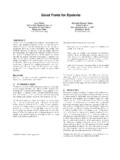Transcription of How Larger Font Size Affects Reading - Welcome - eReadia
1 Research Brief How Larger font size Impacts Reading and the Implications for Educational Use of Digital Text Readers by William E. DeLamater, April 29, 2010. One feature of the Amazon Kindle and other ereaders that has received attention in the past few years is the ability to change font size for the Reading material viewed on the devices. Most writers who have commented on the feature mention their preference for a Larger font size than is typical in a print book. As might be expected, there has been little commentary on the ability to reduce the font size and increase the amount of text visible on each "page". or screen view. The Problem A recent post by a UK blogger that was widely reported carried the headline: "My iPhone has revolutionised my Reading : For dyslexics, books are much easier to read on its screen.
2 ". The writer reports that he finds it easier to read on his iPhone because "the spacing seems generous and because of this I don't get lost on the page." A call to the Dyslexia Society confirmed his observation as one that had been reported by others. Similarly, when middle school students in the US were given the chance to use Kindle ereaders through their school library in support of a Reading intervention program, they reported that increasing the font size on the device helped them read more easily and quickly. A teacher at the school reported that "The font that everyone prefers to use with the Kindle 2 is the largest font size ," and students reported directly that "it's easier for me to read with the Larger font ," and "I read much faster using the Kindle.
3 ". The common preference for a Larger font size raises an interesting question: why does increasing the font size on an ereader lead to an improved Reading experience? The Research Some of the answer involves common sense. Each of the reports above come from readers who struggle with standard text for some reason, either dyslexia (in the case of the blogger in the UK) or below-proficient Reading skills (in the case of the middle schoolers in the US). These readers encounter obstacles in the process of Reading that has interfered with their ability to achieve the Reading proficiency of other readers. They are, in some sense, still learning to read and may require text features and other supports designed for "younger".
4 Readers. Studies show that readers develop the ability to decode smaller and smaller text as they become older and more facile with the process of Reading . Larger text in books for early readers reflects this developmental reality. One study observes "Our data showed that critical print size decreases with age, suggesting younger children need Larger print to Copyright 2010 William E. DeLamater and eReadia LLC. All Rights Reserved . Research Brief optimise Reading performance" (O'Brien, Mansfiled, and Legge, 2005), with critical print size (CPS) referring to that print size that supports optimal Reading rates. This developmental dimension to the relationship between print size and Reading speed tells us that "strugglers".
5 Will achieve their optimal Reading rate when the text is Larger than would be expected for their grade level or chronological age. This finding, though, does not explain why children (and adults) with a specific learning disability like dyslexia require a Larger font size for optimal Reading . A number of studies have addressed this issue. Indeed, the response that the dyslexic blogger in the UK received from the head of the Dyslexia Research Trust focused on an obstacle to Reading rate called "crowding. ". "Many dyslexics have problems with 'crowding', where they're distracted by the words surrounding the word they're trying to read," says John Stein, Professor of Neuroscience at Oxford University and chair of the Dyslexia Research Trust.
6 "When Reading text on a small phone, you're reducing the crowding effect" (Hill, 2010). In the research, crowding specifically refers to "the difficulty in identifying a letter embedded in other letters" (Chung, 2007). Studies have shown that the crowding effect impacts Reading rates in both the horizontal and vertical proximity of text, so that Larger font size creates more space between adjacent letters in the text, and may increase line spacing as well, reducing crowding. Control groups, the "normal" readers in the studies cited, also benefit from reduced crowding. A 2009 study conducted at the University of Rome, Italy, reaches just this conclusion.
7 For both the control and experimental groups, ..the Reading rate increased with print size up to a maximum. In dyslexics, the fastest rate was obtained at a significantly Larger character size than in controls. (Martelli, Di Filippo, Spinelli, and Zoccolotti, 2009). Given the Larger impact on the Reading for students with certain disabilities, increasing text size should be a prime consideration for educators of these students. The O'Brien study concludes: The finding that dyslexic readers require Larger print size to attain their maximum Reading speed has implications for the type of print that educators select for these children (O'Brien, Mansfiled, and Legge, 2005).
8 A study conducted in 2002 entitled " Reading at a distance: implications for the design of text in children's big books" makes specific recommendations about text spacing for younger readers participating in group Reading sessions with a teacher and a "big book": The text in children's books could be made easier to read by expanding the spacing between words and also by increasing the size of the print (Hughes & Wilkins, 2002). The Takeaway Digital text presents a new opportunity to readily adjust the text or font size of Reading material given to students in school. Investigations over the past twenty years into the sources of slower Reading on the part of dyslexic students have identified "crowding" as a central cause.
9 Individuals who have begun Reading on devices such as the Apple iPhone or the Amazon Kindle report a preference for Larger font sizes and an accompanying Copyright 2010 William E. DeLamater and eReadia LLC. All Rights Reserved . Research Brief improvement in the Reading experience. Offering students an opportunity to select an optimal font size for Reading takes advantage of the research base that demonstrates Reading rates improve for all readers when text size is increased and crowding is decreased. Larger font size is especially important for dyslexic students, whose optimal Reading rate requires a Larger font size than that of unimpaired readers.
10 There is a limit to the effect. Studies demonstrate that increasing font size beyond a certain individually determined size does not provide additional advantage to the reader. Self- selection of font size for individual readers seems to be a practical starting place for educators. Digital text and ereading platforms make this possible across a wide range of Reading materials, not just those printed on paper with Larger but fixed print sizes. It appears well supported, however, that increasing font size for all readers correlates positively with improved Reading rates. References Chung, STL. Reading Speed Benefits from Increased Vertical Word Spacing in Normal Peripheral Vision.

